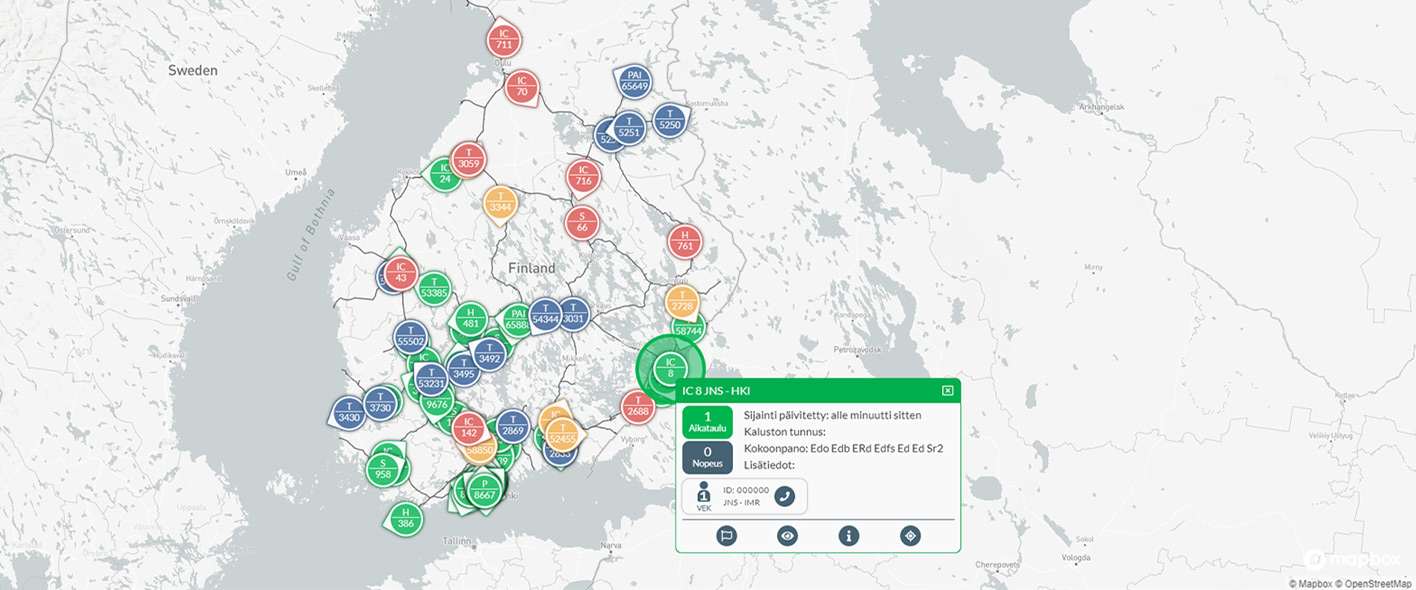
VR Group Operations Centre: Mipro REGO situational awareness system
Mipro has been working in very close collaboration with the Finnish State Railway, VR Group to deliver a GIS-based Situational Awareness system to their Operations Centre.
The work is accomplished by using common development sprints over two years where new features are discussed, evaluated, designed, implemented and introduced according to the need of end users and targets for better efficiency in VR Group’s Operations Centre. During these development sprints, right information is identified from existing systems and integrated with Mipro REGO to have full end to end solution.

AT THE OPERATIONS CENTRE, WE SPECIFICALLY WANT TO INVEST IN THE ANTICIPATION OF DISRUPTIONS, PREPAREDNESS AND QUICK RESPONSE.
USER EXPERIENCES
“Today the Mipro REGO Situational Awareness system is an integral part of our disruption management. It has sped up our capability to react and improved our overall image management. Furthermore, it has given a structured model for our way of working,” says Martti Uusinarkaus, Traffic Information Manager and Project Manager at VR Group’s Operations Centre.
ANTICIPATION OF DISRUPTIONS AND QUICK REACTION AS A GOAL
VR Group’s Operations Centre introduced the Mipro REGO Situational Awareness system in spring 2018. “The Situational Awareness system collects data from dozens of our separate systems into one display and presents this real-time information visually,” says Martti Uusinarkaus. “Furthermore, it gives alarms on conflicts and inconsistencies occurring between these different systems. Thus we are able to prepare for unexpected problem situations and gain time to solve them by digging deeper into the data and finding out what is the reason for the conflict.”
The Operations Centre specifically wants to invest in the anticipation of disruptions, preparedness and quick response. According to Uusinarkaus, the Situational Awareness system has fulfilled this goal: it has improved responsiveness and awareness, and given a more precise overview of the traffic situation.

UNIFIED OVERVIEW THROUGH LARGE SCREEN DISPLAYS
“The Situational Awareness system has improved efficiency in VR Group’s Operations Centre and changed the nature of its work,” adds Uusinarkaus. The centre accesses the system through two large screen displays which simultaneously show all the trains running on the Finnish railway network. The large screen displays are complemented by separate workstations that are used by centre personnel to operate the Situational Awareness system. This means that all the users working in the same location always have a common and unified overview of the traffic situation.
“This is the biggest change the system has brought to our work. Another significant change is that everyone can modify their own view of the same Situational Awareness display on their workstation and monitor matters that are of interest to him/her. This has made the work of an individual dispatcher and supervisor more efficient.”
SELECTING THE COOPERATION PARTNER BY USING POC
The search for a cooperation partner to implement the desired Situational Awareness system was, according to Uusinarkaus, a long process requiring clarifications and benchmarking. The final selection was based on the Proof of Concept (PoC) method which was used to investigate various suppliers in regard to their abilities, resources, personnel and cooperation skills. “Cooperation with Mipro proved to be most efficient when we starting considering the Mipro REGO product. Furthermore, it was important for us to find a supplier that is committed to the product and develops it continuously. That certainly gives us added value.”
FEEDBACK FROM USERS AS BASIS FOR SYSTEM DEVELOPMENT
The Situational Awareness system and its features have been and will be continuously developed by using agile development methods. “The Situational Awareness system has enhanced the Operations Centre activities in such a way that we have been able to take the feedback received from users into account in its development. In order to make the system workable in practice, it definitely requires the involvement of end users. In this respect, we have succeeded excellently. Together we have been able to refine ideas into functions, and by challenging each other, implement them in the system. The value of the Situational Awareness system for VR Group lies precisely in the fact that we are able to develop it continuously.”
VR GROUP’S OPERATIONS CENTRE INVESTS IN TECHNICAL PROWESS
“The Operations Centre is a pioneer that wants to invest in technical prowess,” emphasises Uusinarkaus. “The more effective the Situational Awareness system is and the faster we are able to react, the more noticeable it becomes at all operational levels – by conductors on the train, staff on the marshalling yard – and increases the efficiency throughout the entire organisation.”
“Currently we have a Situational Awareness system that fulfils all our goals. As always in a good project, new ideas and new opportunities open for further development. This is a partnership where together we develop our vision for the Situational Awareness system.”
According to Uusinarkaus, VR Group’s vision is to be the intelligent Operations Centre of the future, where decisions in problem situations are based on data. Data collected and scenarios analysed by the Situational Awareness system form the basis for solutions. Another of the centre’s goals is to put greater efforts into anticipation, to enable the system to sense upcoming problems on the basis of changes in indications. This would allow problems to be addressed even quicker.
VR Group’s Operations Centre coordinates and controls the passenger and freight traffic in the whole of Finland around the clock. The management of daily traffic and possible disruptions, their anticipation and communication to various parties are centralised in the Operations Centre. Furthermore, the centre is responsible for guiding the required vehicle and personnel resources. The centre manages about 1,400 trains per day, 80 million passengers a year and nearly 42 million tons of freight deliveries per year (2019).
